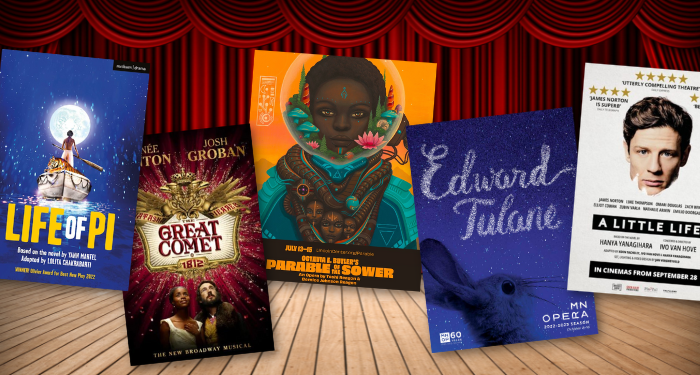
12 of the Most Unexpected Book-to-Stage Adaptations
I consider some books virtually impossible to film because they’re too complex or because showing certain characters or settings would spoil twists the book reveals more gradually. Live theater has some of the same constraints, such as a short time frame. Plus, it has limited space and less potential for stunts and special effects.
This also enables unique forms of creativity in theater that aren’t possible on the page or on film. The energy and chemistry of a live cast and crew recreating a play nightly are irreplaceable. The logistics of accessibility and other safety concerns, or settings like ships on the ocean, work differently on stage and on film.
Some books have too much interiority to translate well to the stage. This was Charles Isherwood’s main critique of plays based on Kafka on the Shore by Haruki Murakami and The Waves by Virginia Woolf in 2008. Woolf was a Modernist writer who helped innovate stream-of-consciousness writing. Murakami is often described as a postmodernist, and Isherwood thought Murakami’s surreal imagery was better suited to a novel than to a play.
Some choices for stage adaptations are baffling. In 2006, a German theater collective performed a play based on parts of Karl Marx’s treatise Das Kapital. As this article says, the book has no plot or characters. So, it seems too abstract and theoretical to work onstage.
Of course, this is all totally subjective, as well as a matter of what theater fans are used to. I think T. S. Eliot’s book Old Possum’s Book of Practical Cats is a strange inspiration for a musical. The show Cats by Andrew Lloyd Webber is one of the most popular stage musicals ever.
I can read some stories that I find too violent or traumatic to watch, either on stage or on film. I find this, especially with plays about sexual assault, where plays make the violence immediate. In 2005, when Alice Walker’s 1982 novel, The Color Purple, became a Broadway musical, some critics thought it was an overly traumatic subject for a musical. Since then, it’s received rave reviews, two Tony Awards, and 11 Tony nominations. The Color Purple is important to both the literary and musical theater canons.
The Kite Runner, a play based on Khaled Hosseini’s bestselling 2003 novel, was staged on Broadway in 2022. This mixed (but mostly negative) review is typical for this production. Rape is central to the story (like in The Color Purple) and changes the characters’ relationships. I love Hosseini’s novels but understand why many of the subtleties might get lost onstage.
A 2022 Dutch stage adaptation of Hanya Yanagihara’s acclaimed bestselling novel A Little Life received similar critiques. According to one critic, the depictions of trauma cross a line on the stage into “bathos.” Also, many disabled writers consider the novel part of a broader, ableist trend of depicting disability as necessarily worse than death.
Sometimes, adaptations make sprawling stories more manageable. It’s hard to imagine staging Leo Tolstoy’s War and Peace in its entirety as a live musical. Dave Malloy, the composer of Natasha, Pierre & The Great Comet of 1812, based his musical on a 70-page segment of Tolstoy’s novel. He said this section has the “perfect structure” to form a Broadway musical. It opened on Broadway in 2016.
In 2022, The Miraculous Journey of Edward Tulane premiered at the Minnesota Opera. Composed by Paola Prestini, it has a libretto by Mark Campbell and is based on Kate DiCamillo’s middle grade novel. The book has been compared to The Velveteen Rabbit and Hans Christian Andersen’s stories. The title character, a toy rabbit, has a touching character arc. His adventures take him from the bottom of the ocean to meeting people who make him less vain. Though it may initially seem like a strange opera subject, it’s an emotional, dramatic story. Both the novel and the opera received positive reviews.
In 2015, Toshi Reagon and Bernice Johnson Reagon adapted Octavia E. Butler’s post-apocalyptic novel Parable of the Sower into an opera. Some reviewers found it preachy or too ambitious to stage; some critics loved it.
From Sheffield and London to Boston and NYC, the play based on Yann Martel’s novel Life of Pi has been a huge hit. The actors and puppeteers both received Olivier Awards in the UK. Theater is immersive in different ways than books, and audiences and critics love the light and sound effects for the ocean and the puppets for the animal characters.
The Drover’s Wife recently reinvented an Australian short story from 1892. Leah Purcell, an Aboriginal Australian playwright, novelist, and actor, adapted and starred in a play and a movie, both loosely based on Henry Lawson’s short story of the same name. Reviewers praised Purcell’s version for portraying the protagonist (a white settler in the original story) as Indigenous and adding new Indigenous characters. This adaptation countered and critiqued the racist stereotypes in the original story.
Ambitious stage adaptations take risks and can be polarizing, but that makes them even more fascinating. Read more about plays adapted from novels. For the reverse, check out these stage-to-book adaptations.










